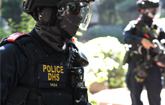ASTHO Applauds Post 9/11 Transformation of U.S. Public Health Preparedness System
ARLINGTON, Va., Sept. 8, 2011 /PRNewswire-USNewswire/ -- Can the U.S. public health preparedness system withstand another terrorist attack or potentially devastating event? The Association of State and Territorial Health Officials (ASTHO) believes it can. In fact, ASTHO believes that experiences of the past decade have spurred a transformation of America's public health preparedness system. Since 2001, states and territories have significantly improved and demonstrated their ability to prevent, respond to, recover from, and reduce the effects of a full range of threats and hazards.
"Since the events of Sept. 11, 2001, state and territorial public health agencies are now more skilled and better equipped to rapidly organize and mobilize emergency care for mass casualties, widely distribute and administer life protecting medications to the public," said John Auerbach, ASTHO President and Commissioner, Massachusetts Department of Public Health. "They are better able to detect and respond to outbreaks, effectively share accurate information with other responders, and relay updates and warnings to the public using traditional and new means of communication," said Auerbach.
Through planning, training, education, drills, exercises, and building partnerships, state public health agencies have improved disease surveillance and laboratory testing, patient care surge capacity, decontamination capacity, and availability and deployment of pharmaceutical and other medical supplies. However, amidst these successes are challenges.
"We have made tremendous progress, yet right now, we are facing challenges in retaining our capacity. Local, state and federal budget cuts are jeopardizing the progress that has been made," said Auerbach. "We must continue to invest in the public health infrastructure so it can remain ready for both everyday and major emergencies. On the national front, we need to reauthorize the Pandemic and All-Hazards Preparedness Act, making it stronger and more effective. One of the lessons of 9/11 is that we must never let our guard down, and that is true, even during these very difficult economic times."
ASTHO is leading by example.
ASTHO works closely with key administration agencies such as the White House National Security Staff, the U.S. Department of Health and Human Services, the Centers for Disease Control and Prevention, the U.S. Department of Homeland Security, and many other important partners such as the Institute of Medicine to develop and improve national policies, practices, and services to better protect the public from all threats, whether it be an act of terrorism or a natural disaster.
With support from the CDC's National Center for Environmental Health, ASTHO is leading the newly created National Alliance for Radiation Readiness (NARR), a group of more than 14 public health, medical and emergency management organizations dedicated to enhancing America's radiological preparedness capability and capacity in the public health and health care systems. Later this month, NARR will unveil a new Web-based clearinghouse of useful tools, resources and best practices to assist state and local responders to be better prepared to respond to radiation and nuclear emergencies.
In the aftermath of the 2009-10 H1N1 influenza pandemic, ASTHO is developing materials to aid public health planners, responders and leaders. These include fact sheets, issue briefs, resource lists, document templates and check lists on such topics as statutory authorities and liability; scope and application of emergency use authorizations for the administration of medical countermeasures such as antibiotics, antivirals, and vaccines; managing public health emergencies in a school or other educational setting; and options and alternatives for expanding the scope of practice health and medical professionals to provide greater surge capacity.
Later this month in St. Louis, ASTHO will convene its seventh annual meeting of the nation's directors of public health preparedness to discuss key strategies and approaches to improve the state of public health readiness for threats and hazards. This will include a reflection on major incidents over the past year such as the Gulf Coast Deepwater Horizon oil rig disaster; the Japan earthquake, tsunami and nuclear reactor radiation release crisis; Hurricane Irene; and the spring tornados and flooding; a discussion of lessons learned; and identifying ways to continually improve America's ability to protect the public.
On Sept. 14, Paul Jarris, ASTHO Executive Director, will address the National Emergency Management Summit in New York City and provide a 10-year reflection on public health emergency preparedness. Additionally, ASTHO's annual meeting schedule in October includes a session on preparedness titled "Sept. 11th: 10 Years of Reflection, Preparedness, Progress and Building Resilience." The session will feature senior federal and state preparedness leaders including Heidi Avery, deputy assistant to the president for Homeland Security.
"It took 102 minutes for the terrorist attacks of Sept. 11, 2001, to completely unfold. This unprecedented act of aggression shattered families, devastated communities and left Americans everywhere feeling vulnerable," said Jarris. "ASTHO joins the entire nation in remembering and honoring the victims of that day and in extending heartfelt sympathy to the families they left behind. We owe it to their memory, and to the well-being of all of America's families, to commit our efforts and resources to help state and territorial public health agencies continually elevate their disaster preparedness planning and response activities against any emergency and every threat."
SOURCE Association of State and Territorial Health Officials
WANT YOUR COMPANY'S NEWS FEATURED ON PRNEWSWIRE.COM?
Newsrooms &
Influencers
Digital Media
Outlets
Journalists
Opted In






Share this article